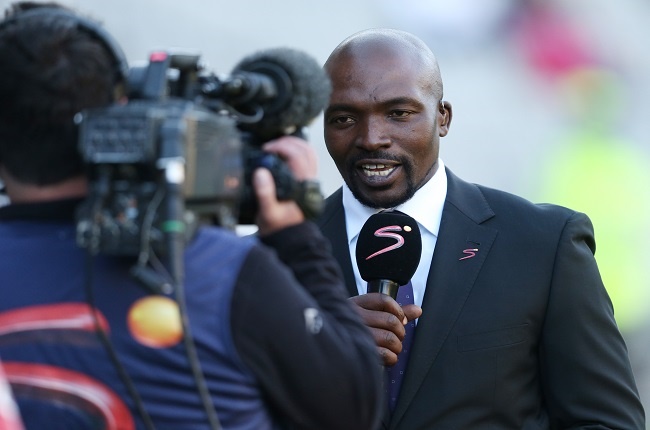


SuperSport commentator Owen Nkumane. (Gallo Images)
- This weekend’s Solidarity Cup will be South Africa’s first local live sporting event since lockdown and will set in motion a brave new era of broadcasting.
- The Covid-19 pandemic has already forced SuperSport to diversify its product offerings in the absence of action, but industry experts state live sport still remains the lifeblood of the medium.
- The Premier League’s return summarily broke viewership records and the PSL and rugby’s respective return should also attract similar attention.
- However, productions will need to include new layers, particularly when it comes to increasing the sense of community viewers receive from events like the resurgence of the Black Lives Matter movement.
On Saturday, the Solidarity Cup – the world’s first taste of 3 Team Cricket – will be significant for broadcasting in South Africa.
Not only will it be the first live local sporting event since the country went into lockdown back at the end of March, it is an event likely usher in an era of adjustment and innovation.
“Every sports broadcaster in the world has had to re-examine its content,” Kelvin Watt, a director at analytics firm Nielsen Sports South Africa, told Sport24.
“Over the past few years, trends for the future of broadcasting has emerged, but the Covid-19 pandemic, which forced live sport to a standstill until recently, has accelerated the process.”
Andile Qokweni, the business unit manager at The MediaShop, agreed.
In recent blog post, he noted: “Not only are the big multinationals having to adjust to the changing landscape of the broadcasting business but added to that we have the pandemic, which as mentioned upfront, has been cancelled for the first time since World War II.
“Sport will be forced to evolve and adapt as it did throughout the 1900s and early [2000s].”
South African sport junkies have already experienced how the coronavirus crisis has forced SuperSport to adapt, notably the strange but pleasing sight of an increased number of in-depth documentaries and Hollywood blockbusters.
“SuperSport, for the first time since its own inception, was screening a cocktail of the finest sports-based movies with a sprinkling of its viewers’ best moments from the past two decades,” wrote Qokweni.
It confirms the trend of consumers of sport desiring more intimate, revealing content.
“We’ve seen it, SuperSport, screening a multitude of documentaries and the huge success of The Last Dance, Netflix’s documentary series on Michael Jordan’s career,” said Watt.
“Modern viewers crave footage and insights directly of an athlete. They want a glimpse into their lives as well as what goes on behind the scenes when they prepare for their feats on the field of play.”
Yet the commercial imperative of having to develop a more diverse product offerings should not distract broadcasters from the importance of live sporting content.
“It’s arguably more important than ever before,” said Watt.
“The return of the English Premier League has already broken viewership records in South Africa and in the UK. Locally, we can expect the PSL to attract massive interest once it returns to screens and if SA Rugby can manage to organise a full, two-round Currie Cup competition, we can expect viewership to peak back to levels last experienced in 2009 and 2010.
“The numbers we’ve gathered of the past few weeks show what an important part live sport plays in viewers’ lives.”
Complacency, however, is a danger as broadcasters could easily fall into the trap of riding on the wave of the novelty of live events steadily returning without critically evaluating the need for a new layer of content.
Watt pointed out British broadcasters have excelled in jazzing up their coverage of the Premier League and the Test series between England and the West Indies.
Multiple commentary teams have been assembled for days when multiple football matches are played simultaneously and interactivity with viewers were increased to add colour.
Sky Sports had the neat idea of “popping in” to see how village cricket’s resumption was going during the Test in Southampton.
In contrast, its counterpart in New Zealand has hardly deviated from its previous model of match-day coverage in Super Rugby Aotearoa.
Granted, the presence of spectators means the Kiwis probably have a bigger sense of normality currently that might not warrant any fancy new additions to the production, but the point stands.
“If the novelty wears off and you haven’t determined how you’re going to keep your viewership substantial, then you might run into problems later,” said Watt.
Qokweni believed pure sentimentality should not be underestimated.
“In here lies the magic of sports and broadcasting. Being in the sport industry means that you are in the entertainment business. Rather than selling a product, you are selling the anticipation of what is going to happen and you need to give consumers memories to take away,” he wrote.”Importantly, it is the memories that keep sport fans coming back every season. For this reason, sport as a business will evolve and find new and more meaningful ways to connect with its consumers.”
One obvious but deeply significant example is the Black Lives Matter (BLM) movement.
“The Covid-19 pandemic has emphasised sports broadcasting’s roles in fostering humanity and promoting community,” said Watt.
“We’ve seen it with the inserts of the village cricketers and how commentators have actively engaged in on-screen talks over Black Lives Matter. It’s causes that are important to viewers and refining a product to include such elements of community is vital.
“Sport broadcasting really isn’t just about what happens between four lines anymore.”

